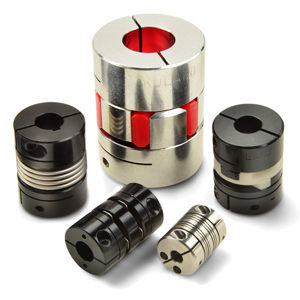Zero-Backlash Couplings
Shaft coupling backlash occurs as a result of play or looseness between coupling components. Backlash is not problematic in many systems such as those that run in a single direction continuously. These applications, pumps for example, do not require a high level of precision making a coupling with backlash suitable.
Zero-backlash couplings, as their name suggests, are free of backlash due to their design. In precision positioning applications such as those found in machine vision, robotics, medical, and semiconductor, backlash free couplings are used when one-to-one power transmission is required for the system to perform as needed. Ruland only manufactures and offers zero-backlash couplings (below) designed for use in high performance systems. Click the couplings to browse and learn more or explore all Ruland zero-backlash couplings zero backlash couplings.


| Coupling | Torsional Rigidity |
Torque | Bearing Loads |
Inertia | Angular Misalignment |
Parallel Misalignment |
Axial Motion |
Maintenance Required |
|---|---|---|---|---|---|---|---|---|
Beam Couplings |
Low | Low | Moderate | Low | High | Moderate | Moderate | No |
Beam Couplings |
Moderate | Moderate | Moderate | High | High | Moderate | Moderate | No |
Bellows Couplings |
High | High | Moderate | Low | Low | Low | Low | No |
Jaw Couplings |
Low | Low | Low | Low | Low | Low | High | Yes |
Jaw Couplings |
Moderate | Low | Low | Low | Low | Low | High | Yes |
Jaw Couplings |
Moderate | High | Low | Low | Low | Low | High | Yes |
Oldham Couplings |
High | Low/ Moderate |
Low | Low | Low | High | Low | Yes |
Oldham Couplings |
High | Moderate | Low | High | Low | High | Low | Yes |
Controlflex Couplings |
Low | Low | Low | Low | Moderate | High | High | Yes |
Disc Couplings |
High | High | Moderate | Low | Low | N/A | Low | No |
Disc Couplings |
High | Low/ High |
Low | Low | Moderate | Low | Moderate | No |
Slit Couplings |
Moderate | Moderate | Low | Low | High | High | High | No |
The Importance of Zero-Backlash Couplings
What Is Coupling Backlash?
Backlash refers to lost motion as a result of gaps between parts, such as tenons and inserts or gear teeth. When something like a motor and lead screw is connected to coupled parts, this looseness causes the transmission of motion to be less than one to one. A single instance of lost motion is not critical in most systems, such as single-direction, continuously running pumps, but repeated motion loss causes the motor/encoder to lose position.
In the case of shaft couplings this is most often seen in applications with reversing, such as machine vision systems that move back and forth rapidly along multiple axes. Each time the coupling reverses direction, any play within the coupling translates to a small loss of motion between power transmission from shaft to shaft. In the case of a machine vision system, this manifests as inaccurate location of the vision equipment, leading to inaccurate readings.
In other applications where precise positioning is critical, such as semiconductor etching, the tiniest inaccuracy in power transmission can cause expensive errors and the need to replace the wafer. In cases where safety is a factor, such as in medical robots, a designer would only use a coupling with zero-backlash.
How Do Zero-Backlash Couplings Differ From Other Couplings?
As previously discussed, lost motion in couplings with backlash is caused by play or looseness within the coupling itself. This is found in couplings that use a flexible center to accommodate shaft misalignment. A good example is the commonly used straight jaw coupling. Jaw couplings are comprised of two hubs and an elastomeric spider which provides misalignment accommodation and, depending on the durometer of the spider, varying torsional stiffness and dampening characteristics. In straight type jaw couplings there is clearance between the spider and the hubs that leads to coupling backlash.
Some manufacturers, like Ruland, offer curved zero-backlash jaw couplings that press fit with the spider to eliminate play between the components. Neither straight nor curved type jaw couplings are inherently better and the optimal choice varies by application.
How Do I Choose The Right Coupling?
The shaft coupling market is highly developed with many standard options to suit application requirements. Most manufacturers do not specifically state that a coupling has backlash. If the coupling is not labeled “zero-backlash”, “backlash free”, or something similar, there is almost certainly play or looseness present. When in question, consult directly with the manufacturer. Some couplings may also be described as “minimal backlash” or “near zero-backlash”, however these are often not suitable for precision systems.
The acceptability of backlash is dependent on system requirements. If you need one-to-one power transmission, zero-backlash is nonnegotiable. Applications with frequent starts, stops, and/or reverses often require zero-backlash to function efficiently, as any discrepancy between input and output shafts can result in positioning errors. If your system is less precise than that and is likely to primarily require one-directional movement, a shaft coupling with backlash may be fine.
Backlash is one of many considerations when selecting a shaft coupling. Use our coupling comparison chart to compare the various strengths and weaknesses of every Ruland servo coupling or check out our technical articles. Most importantly, remember that it is ultimately up to the designer to understand determine if a zero-backlash coupling is right for the application. As we always say, test, test, test.










